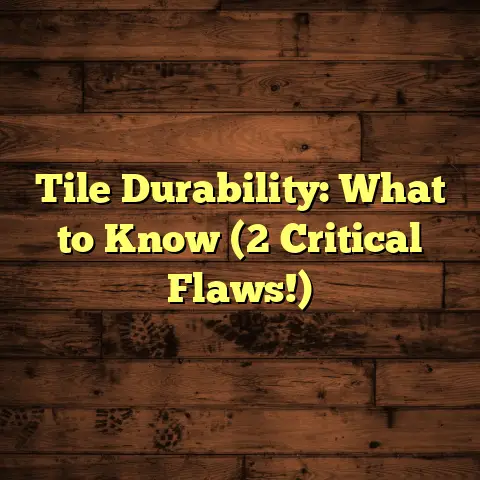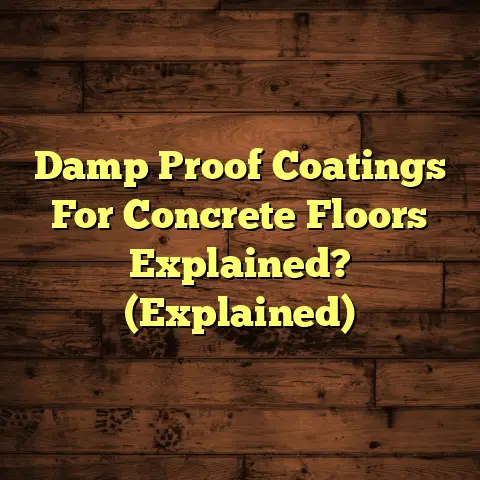Filling Wood Floor Gaps: How To? (1 Trick Pro’s Use!)
And one thing that consistently pops up? Those pesky gaps in wood floors. They’re like little gremlins that sneak in and ruin the overall look.
But don’t worry, I’m here to share a secret weapon – the one trick pros use to tackle those gaps head-on! Let’s dive in, shall we?
1. Understanding Wood Floor Gaps
So, what exactly are wood floor gaps? Simply put, they’re the spaces that form between your wood floorboards.
Think of them as expansion joints gone rogue. They’re more than just a cosmetic issue; they can impact your home’s energy efficiency and even harbor unwanted guests.
What Causes These Gaps?
-
Seasonal Changes: Wood is a natural material, and it reacts to its environment. In the winter, when humidity levels drop, wood shrinks, creating gaps.
Conversely, in the summer, when humidity rises, the wood expands, and those gaps might disappear (temporarily, at least!).
According to the Forest Products Laboratory, wood can shrink or swell up to 6% in width as moisture content changes. (Source: https://www.fpl.fs.fed.us/)
-
Humidity: Consistent high or low humidity levels can wreak havoc on your wood floors. Ideally, you want to maintain a humidity level between 30-50% in your home.
I’ve seen floors in homes without proper humidity control develop massive gaps in just a few years.
-
Aging: As wood ages, it naturally dries out and can become more prone to shrinking. This is especially true for older homes with original hardwood floors.
-
Improper Installation: Sometimes, gaps are simply the result of poor installation. If the wood wasn’t properly acclimated before installation or if the subfloor wasn’t level, gaps are almost inevitable.
Solid vs. Engineered: How They React
It’s crucial to understand the type of wood flooring you have. Solid hardwood is a single piece of wood, making it more susceptible to expansion and contraction.
Engineered hardwood, on the other hand, is made of multiple layers of wood glued together, making it more stable and less prone to gapping.
Here’s a quick comparison:
| Feature | Solid Hardwood | Engineered Hardwood |
|---|---|---|
| Construction | Single piece of wood | Multiple layers of wood |
| Stability | Less stable | More stable |
| Gap Susceptibility | More susceptible to gaps | Less susceptible to gaps |
| Cost | Generally more expensive | Generally less expensive |
2. Why Filling Gaps is Important
Okay, so you’ve got gaps. Why bother filling them? Well, here’s the lowdown:
-
Improved Appearance: Let’s face it, gaps are unsightly. Filling them instantly improves the look of your floors and your entire room. It restores that seamless, elegant feel.
-
Increased Energy Efficiency: Gaps can let in drafts, making your home less energy-efficient. Filling them helps seal your home and reduce energy costs.
According to the U.S. Department of Energy, sealing air leaks can save homeowners 5-15% on their energy bills. (Source: https://www.energy.gov/)
-
Prevention of Further Damage: Gaps can trap dirt, debris, and moisture, leading to further damage to your floors. Filling them prevents this accumulation and protects your investment.
-
Pest Control: Gaps can become havens for pests like insects and spiders. Filling them eliminates these hiding spots and keeps your home pest-free.
Addressing Homeowner Concerns
I often hear homeowners say, “But won’t the wood just expand and contract again?” That’s a valid concern!
That’s why it’s crucial to use the right materials and techniques. I’ll guide you through it.
3. The Professional’s Secret: The Trick to Filling Gaps
Alright, drumroll please… The pro’s secret weapon for filling wood floor gaps is… wood filler mixed with wood dust!
Yep, it’s that simple. But the execution is key.
Why This Works
-
Color Matching: By using wood dust from your floors, you create a filler that perfectly matches the color of your existing wood. No more unsightly mismatched patches!
-
Flexibility: The wood dust helps the filler move with the natural expansion and contraction of the wood, reducing the risk of cracking.
-
Seamless Integration: The wood dust creates a more natural-looking finish, blending seamlessly with the surrounding wood.
Materials You’ll Need
- Wood Filler: I recommend a high-quality, stainable wood filler. My go-to is [Brand Name], but there are many great options out there.
- Wood Dust: This is the star of the show! You can collect wood dust by sanding your floors (more on that later) or from a local woodworking shop.
- Putty Knife: For applying the filler.
- Sanding Block or Sander: For smoothing the filled gaps.
- Vacuum Cleaner: For cleaning the gaps.
- Painter’s Tape: To protect the surrounding wood.
- Gloves: To keep your hands clean.
- Safety Glasses: To protect your eyes.
4. Step-by-Step Guide to Filling Wood Floor Gaps
Okay, let’s get down to business! Here’s a detailed guide on how to fill those gaps like a pro.
Preparation
-
Gather Your Tools and Materials: Make sure you have everything you need before you start. Nothing’s worse than realizing you’re missing something halfway through the project.
-
Safety First: Wear gloves and safety glasses to protect yourself. Ensure the room is well-ventilated, especially if you’re using solvent-based fillers.
-
Prepare the Wood Dust: If you’re sanding your floors to collect wood dust, use a fine-grit sandpaper (120-grit or higher). Collect the dust in a container.
You can also get wood dust from a local woodworker. Just make sure it’s from the same type of wood as your floors.
Cleaning the Gaps
This is crucial! You need a clean surface for the filler to adhere properly.
-
Vacuum the Gaps: Use a vacuum cleaner with a crevice tool to remove any loose dirt and debris from the gaps.
-
Scrub the Gaps: Use a stiff brush or a putty knife to scrub the gaps and loosen any stubborn dirt.
-
Vacuum Again: Vacuum the gaps again to remove any remaining dirt.
Application of the Filler
Now for the fun part!
-
Mix the Filler: In a small container, mix the wood filler with the wood dust. Start with a small amount of dust and gradually add more until you achieve a paste-like consistency.
The goal is to create a filler that closely matches the color of your wood.
-
Apply Painter’s Tape: Apply painter’s tape along the edges of the gaps to protect the surrounding wood.
-
Apply the Filler: Using a putty knife, apply the filler to the gaps. Press firmly to ensure the filler fills the entire gap.
Overfill the gaps slightly, as the filler will shrink as it dries.
-
Remove Excess Filler: Use the putty knife to remove any excess filler from the surface of the wood.
-
Let it Dry: Allow the filler to dry completely according to the manufacturer’s instructions. This usually takes 24-48 hours.
Finishing Touches
-
Sand the Filled Gaps: Once the filler is dry, use a sanding block or a sander with fine-grit sandpaper (220-grit or higher) to sand the filled gaps smooth.
Be careful not to sand too much, as you don’t want to damage the surrounding wood.
-
Remove Painter’s Tape: Carefully remove the painter’s tape.
-
Clean the Area: Vacuum the area to remove any sanding dust.
-
Seal the Floor: To protect the filled gaps and enhance durability, apply a coat of sealant to the floor. I recommend [Brand Name] sealant.
5. Common Mistakes to Avoid
-
Using the Wrong Filler: Don’t use just any filler! Using the wrong type of filler can result in cracking, shrinking, or mismatched colors.
-
Not Cleaning the Gaps: This is a big one! If you don’t clean the gaps properly, the filler won’t adhere correctly, and it will eventually fall out.
-
Applying Too Much Filler: Overfilling the gaps can make sanding more difficult and can result in an uneven finish.
-
Not Sanding Smoothly: If you don’t sand the filled gaps smoothly, they will be noticeable and unsightly.
-
Skipping the Sealant: Sealing the floor after filling the gaps is crucial to protect the filler and enhance durability.
6. Maintenance and Care After Filling Gaps
Okay, you’ve filled the gaps – congratulations! Now, let’s talk about maintenance.
-
Humidity Control: Maintain a consistent humidity level in your home (30-50%). Use a humidifier in the winter and a dehumidifier in the summer.
-
Regular Cleaning: Sweep or vacuum your floors regularly to remove dirt and debris.
-
Avoid Wet Mopping: Use a damp mop with a wood floor cleaner instead of a wet mop.
-
Inspect Regularly: Inspect your floors regularly for any new gaps or cracks. Address them promptly to prevent further damage.
7. Conclusion
So, there you have it – the pro’s secret to filling wood floor gaps! It might seem like a daunting task, but with the right materials, techniques, and a little patience, you can restore the beauty and elegance of your wood floors.
Remember, those gaps are more than just a cosmetic issue. By addressing them, you’re improving your home’s energy efficiency, preventing further damage, and creating a healthier living environment.
Don’t be afraid to tackle this project yourself. You’ve got this! And if you ever need help, don’t hesitate to call a professional.
Now go forth and create a home environment that reflects your personal style and comfort! Happy flooring!





